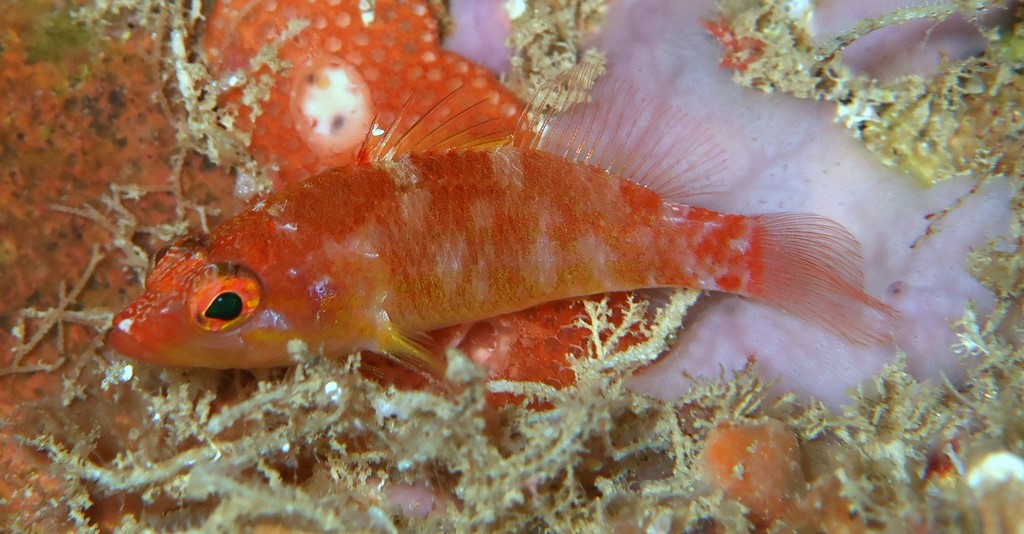PLECTRANTHIAS WINNIENSIS - (TYLER, 1966)
Picture courtesy of: Alain Daoulas
Actinopterygii (Gigaclass) > Actinopteri (Class) > Teleostei (Subclass) > Perciformes (Order) > Percoidei (Suborder) > Anthiadidae (Family) > Plectranthias (Genus)
Redblotch basslet, Redblotch perchlet, 紅斑棘花鮨,
Synonyme
Pteranthias winniensis (Tyler, 1966)
-------------------------
Description
Dorsal spines (total): 10; Dorsal soft rays (total): 15-17 (usually: 16), the fin margin notched almost to the base before soft-rayed part, fourth spine usually longest, 14-17% SL, 2.4-3.1 in head length. No banner or cirrus at tip of dorsal-fin spines; Anal spines: 3; Anal soft rays: 7, second spine slightly longer than third spine; Caudal fin rounded, branched rays: 13; Pectoral fin rays: 16-18, all unbranched; Fin length: 1.0-1.7 in head and reaching to between verticals at second anal-fin spine and third anal-fin ray; Pelvic fins reaching 1-3 mm less than anus, 1.5-1.8 in head. Vertebrae 10 + 16. Body oblong, greatest depth: 2.8-3.2, head length 2.3-2.4 in SL; Peduncle depth: 2.9-3.7, orbit diameter: 3.0-2.7, snout: 4.4-5.7, bony interorbital width: 10-11 in head. Lateral-line incomplete, with 8-27 tubed scales ending below soft dorsal fin; 1-2 rows of scales between fith dorsal-fin spine and lateral-line; Circum-peduncular scales: 13-14; Top of head scaly to mid interorbital area; Cheek with: 4-5 oblique series of large scales, the fith series mostly covered by scales of the fourth series; Snout, maxilla, suborbitals and lower jaw naked. Supramaxilla rudimentary or absent. Preopercle rounded, finely serrate, lower edge with two antrorse spines hidden by skin; Subopercle and interopercle with 0-2 weak serrae. Gill rakers: 4-6 + 11-15. Max. length: 4.0 cm SL. Depth range: 23 - 116 m.
Color
Head and body russet to reddish orange, with dusky scales dorsally; Abdomen yellow-orange; Dorsal and anal fins yellow proximally, transparent distally with pale pink rays; Red blotch at base of last three anal-fin rays and at base of first three dorsal-fin spines; Caudal fin transparent, the rays silvery red; White-edged red spot at base of lower six rays.
Etymology
Plectranthias: from Greek, plektron = anyhting to strike with, spur + from Greek, anthias = a name of an unknow fish given by Aristotle in "History of Animals". This book, written in the fourth century BC, is one of the major texts on biology by the ancient Greek philosopher Aristotle (384–322 BC), who had studied at Plato's Academy in Athens.
winniensis: called in allusion to Winnie's, a most pleasant place on the island of Mahé in the Seychelles.
Original description: Pteranthias winniensis Tyler, 1966 - Type locality: Saint Joseph Atoll, Amirante Group, Seychelles, western Indian Ocean, 5°26'S, 53°22'E, depth 50-90 feet (15-27 meters).
Distribution
Red Sea, Indo-West Pacific: East and South Africa, Seychelles, Comoro Islands, Mascarenes and Fiji east to Hawaiian Islands and Tuamotu Archipelago, Japan and south to New Caledonia, Tonga and Great Barrier Reef, Australia.
Biology
Occurs along outer reef slopes and caves. Benthic. Solitary and cryptic.
Similar species
Plectranthias maekawa (Wada, Senou & Motomura, 2018) - Reported from Northwestern Pacific: Tokara Islands, Ryukyu Islands (Japan).
Last update: 16, June 2022
Actinopterygii (Gigaclass) > Actinopteri (Class) > Teleostei (Subclass) > Perciformes (Order) > Percoidei (Suborder) > Anthiadidae (Family) > Plectranthias (Genus)
Redblotch basslet, Redblotch perchlet, 紅斑棘花鮨,
Synonyme
Pteranthias winniensis (Tyler, 1966)
-------------------------
Description
Dorsal spines (total): 10; Dorsal soft rays (total): 15-17 (usually: 16), the fin margin notched almost to the base before soft-rayed part, fourth spine usually longest, 14-17% SL, 2.4-3.1 in head length. No banner or cirrus at tip of dorsal-fin spines; Anal spines: 3; Anal soft rays: 7, second spine slightly longer than third spine; Caudal fin rounded, branched rays: 13; Pectoral fin rays: 16-18, all unbranched; Fin length: 1.0-1.7 in head and reaching to between verticals at second anal-fin spine and third anal-fin ray; Pelvic fins reaching 1-3 mm less than anus, 1.5-1.8 in head. Vertebrae 10 + 16. Body oblong, greatest depth: 2.8-3.2, head length 2.3-2.4 in SL; Peduncle depth: 2.9-3.7, orbit diameter: 3.0-2.7, snout: 4.4-5.7, bony interorbital width: 10-11 in head. Lateral-line incomplete, with 8-27 tubed scales ending below soft dorsal fin; 1-2 rows of scales between fith dorsal-fin spine and lateral-line; Circum-peduncular scales: 13-14; Top of head scaly to mid interorbital area; Cheek with: 4-5 oblique series of large scales, the fith series mostly covered by scales of the fourth series; Snout, maxilla, suborbitals and lower jaw naked. Supramaxilla rudimentary or absent. Preopercle rounded, finely serrate, lower edge with two antrorse spines hidden by skin; Subopercle and interopercle with 0-2 weak serrae. Gill rakers: 4-6 + 11-15. Max. length: 4.0 cm SL. Depth range: 23 - 116 m.
Color
Head and body russet to reddish orange, with dusky scales dorsally; Abdomen yellow-orange; Dorsal and anal fins yellow proximally, transparent distally with pale pink rays; Red blotch at base of last three anal-fin rays and at base of first three dorsal-fin spines; Caudal fin transparent, the rays silvery red; White-edged red spot at base of lower six rays.
Etymology
Plectranthias: from Greek, plektron = anyhting to strike with, spur + from Greek, anthias = a name of an unknow fish given by Aristotle in "History of Animals". This book, written in the fourth century BC, is one of the major texts on biology by the ancient Greek philosopher Aristotle (384–322 BC), who had studied at Plato's Academy in Athens.
winniensis: called in allusion to Winnie's, a most pleasant place on the island of Mahé in the Seychelles.
Original description: Pteranthias winniensis Tyler, 1966 - Type locality: Saint Joseph Atoll, Amirante Group, Seychelles, western Indian Ocean, 5°26'S, 53°22'E, depth 50-90 feet (15-27 meters).
Distribution
Red Sea, Indo-West Pacific: East and South Africa, Seychelles, Comoro Islands, Mascarenes and Fiji east to Hawaiian Islands and Tuamotu Archipelago, Japan and south to New Caledonia, Tonga and Great Barrier Reef, Australia.
Biology
Occurs along outer reef slopes and caves. Benthic. Solitary and cryptic.
Similar species
Plectranthias maekawa (Wada, Senou & Motomura, 2018) - Reported from Northwestern Pacific: Tokara Islands, Ryukyu Islands (Japan).
Last update: 16, June 2022
